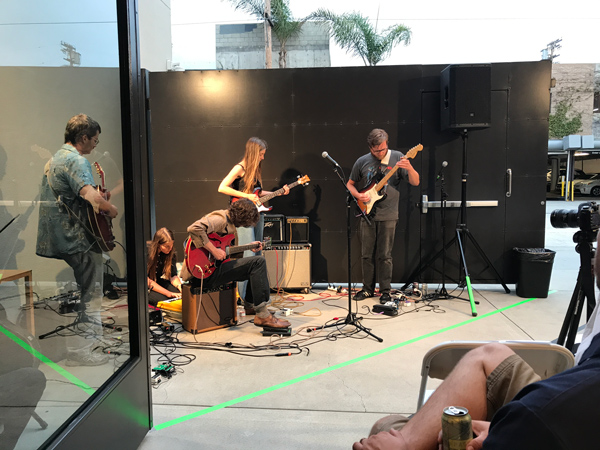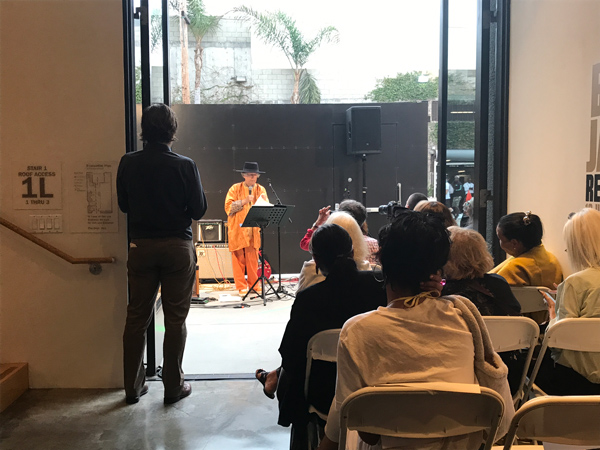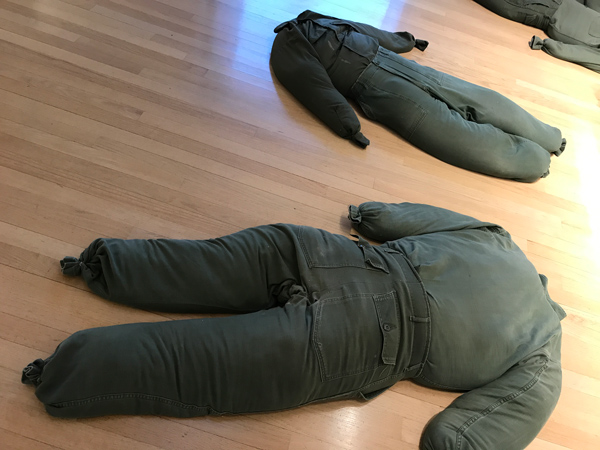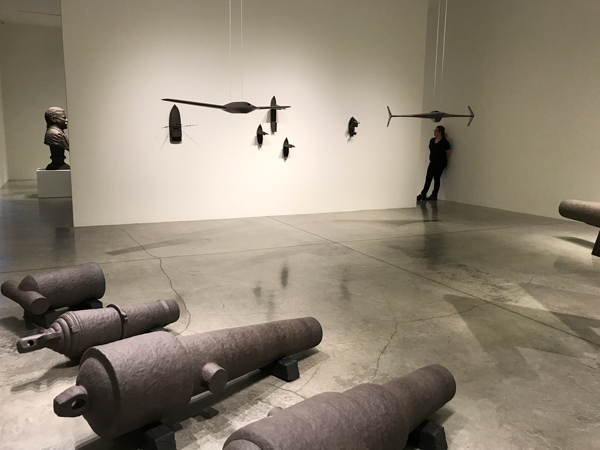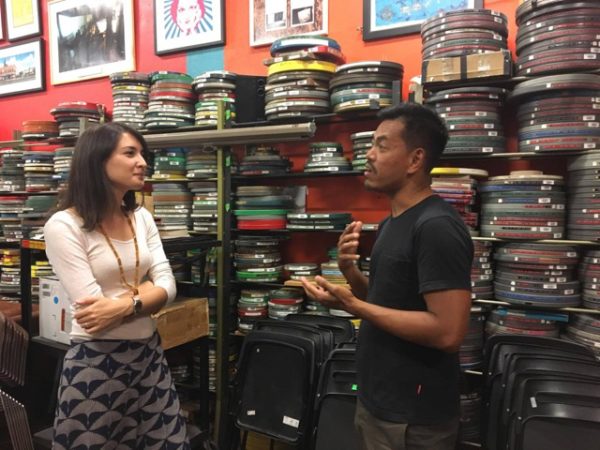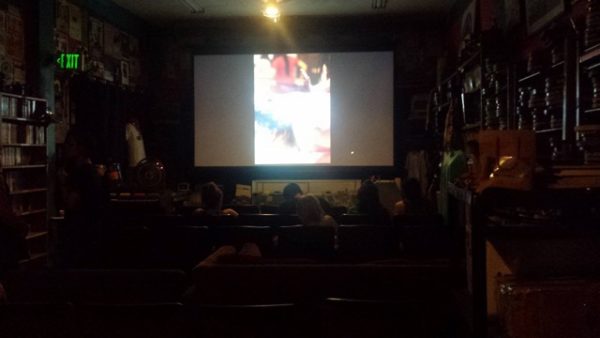Your cart is currently empty!
Byline: Lillian Kalish
-

Protest in Poetry at L.A. Louver
Sporting an orange kaftan shirt and a wide-brimmed black hat perched atop his head, poet Stephen Kalinich looked more like he was ready for a wild trip than for a reading.
“I, the poet, write this plea to the world,” he began the evening, noting that he first read this line in 1968, in the midst of the Vietnam War, the assassination of Martin Luther King Jr. and the seeming demise of America.

Stephen Kalinich reads from his selection of protest poems. Now, in times when many of the non-political find themselves anew in activism, Kalinich felt compelled to make a poetic statement against injustice. His far-out look didn’t detract from his rallying cry for peace which he disseminated among the older art crowd at L.A. Louver gallery in the heart of Venice Beach on August 23.
Earlier this month, the poet and Beach Boys collaborator read a series of protest poems, first written in the late 1960s and 1970s, followed by a performance by Los-Angeles-based, non-hierarchical music collective known as Divinity Band.

Edward Kienholz’ ceramic corpses lie in front of his “Non War Memorial.” The performance, “Night of Protest Songs,” was held alongside L.A. Louver’s ongoing exhibitions, Ben Jackel’s “Reign of Fire” and Edward and Nancy Kienholz’ “The Non War Memorial,” “Still Dead End Dead” and “The Jungen.”
Amidst poetics and music, guests were encouraged to stroll about the gallery, pondering Jackel’s ceramic and wooden sculptures of war, covered in an ominous sheen of graphite or Kienholz’ disturbing lifeless figures, splayed on the floor in military dress as if freshly killed.
Though many seemed to be jiving with Kalinich’s universal message as the violence and wars of the past resurfaced to the room, I could not help but find his prose to be entombed in the political platitudes of the past, falling on already sympathetic ears.
So it goes, I suppose, a reading right in the changing heart of left-leaning Dogtown—the revolution may not happen here, not now. But at the very least, it is on our minds.

Ben Jackel’s ceramic fleet of cannons and fighter jets. However, the Divinity Band, a five-person band, verging on anarchy with their refusal to own their music and their ever changing membership, left much up to interpretation with their non-vocal distorted, improvisations.
Each musician carved their own path whether by guitar, bass, electric harp or synthesizer. Together the dissonant rhythms, though imperfect and crooked, propelled me into the present.
I mounted L.A. Louver’s upper level to view the “Non War Memorial” and moved out to the patio—a white box facing the boundless blue sky—to experience a moment of solitude with the music and Kalinich’s words.
Momentarily in that private place, walls adorned with silence and the sky above as my only witness, I felt intoxicated with the now, with the discord in the music heard below, the possibility to begin again and the always incomplete articulation of revolt.
-

Ethnocinema at the Echo Park Film Center
Can cinema be a safe space? This is the question that drove filmmaker and PhD candidate Nerve Valerio to curate the Action! Cinema as Sanctuary series at the Echo Park Film Center in the heart of Echo Park.
Following the election of President Trump, Valerio, like many of those feeling both distraught and a renewed sense of politicization, asked to the void, “What now?”
His answer: a series of politically engaged film screenings, covering issues pertinent to the experiences of immigrants, refugees, POC, LGBTQ+ folks, and more from around the globe.
The most recent screening last Saturday featured Nobel Nok Dah and For My Art, two ethno-documentaries by Emily Hong and co-directors Mariangela Mihai and Miasarah Lai, who make up half of the ethnographic film collective, Ethnocine. The two films explored the often unheard experiences of Burmese women refugees in the U.S. and Burmese women performance artists in Burma/Myanmar’s former capital, Yangon.

During the screening. I had come to the Echo Park Film Center on a whim, curiously wading through the small, intimate cinema/rental store/film library/workshop space alongside budding filmmakers, EPFC alumni, artist-in-residence Kaori Oda, and other inquisitive guests.
Though I was aware of Hong’s work, as I had interviewed and finally met her in Yangon last year where I was working as a journalist and she was screening For My Art at the independent Wathann Film Festival, I had actually never seen her films in full.
In Nobel Nok Dah, which follows three Burmese refugees in upstate NY, Hong constructs a new kind of narrative form. Without a typical interview shot taking precedence, the audience becomes attuned to other aspects of these women’s lives.

A still of artist Phyu Mon painting a boy’s hand in northern Yangon. Photo: Emily Hong Foremost, their voices — shaky yet determined. Brief shots of B-roll offer a view of their lives in motion. One woman practices traditional Burmese dance. Another washes dishes, rides the bus. Another plays with her child in the forest, wishing her child only a happy life. Slowly, and in a somewhat obscure way of filming, I sensed the film was mirroring the women’s own feelings of displacement and otherness.

“Nobel Nok Dah” movie poster. Photo: Emily Hong This alluring and unconventional form of filmmaking prevailed throughout the night with the screening of For My Art, which follows female performance artists around Yangon. Watching the film was slightly surreal for me, as only months ago in Yangon I had met and shared meals with provocative explorer of gender, Ma Ei and artist-activist Zoncy.

A still of For My Art featuring artist Ma Ei. Photo: Emily Hong When the screenings ended, Hong fielded audience questions ranging from film technique to Myanmar geo-politics. As the small crowd shuffled across the room and out the door, I thought to myself about the strange coincidences that led me here that night —Myanmar, the rise of Trump, and a fledging career in art writing… could there be no safer space than this?
